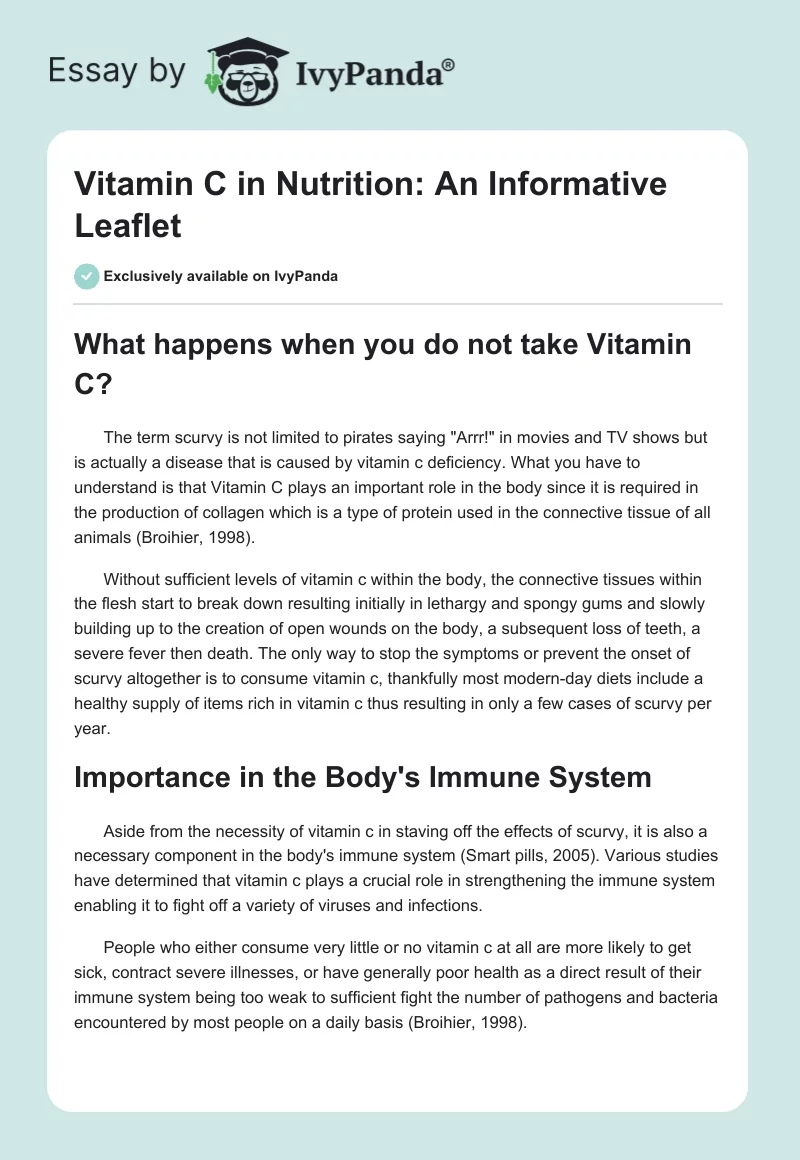What happens when you do not take Vitamin C?
The term scurvy is not limited to pirates saying “Arrr!” in movies and TV shows but is actually a disease that is caused by vitamin c deficiency. What you have to understand is that Vitamin C plays an important role in the body since it is required in the production of collagen which is a type of protein used in the connective tissue of all animals (Broihier, 1998).
Without sufficient levels of vitamin c within the body, the connective tissues within the flesh start to break down resulting initially in lethargy and spongy gums and slowly building up to the creation of open wounds on the body, a subsequent loss of teeth, a severe fever then death. The only way to stop the symptoms or prevent the onset of scurvy altogether is to consume vitamin c, thankfully most modern-day diets include a healthy supply of items rich in vitamin c thus resulting in only a few cases of scurvy per year.
Importance in the Body’s Immune System
Aside from the necessity of vitamin c in staving off the effects of scurvy, it is also a necessary component in the body’s immune system (Smart pills, 2005). Various studies have determined that vitamin c plays a crucial role in strengthening the immune system enabling it to fight off a variety of viruses and infections.
People who either consume very little or no vitamin c at all are more likely to get sick, contract severe illnesses, or have generally poor health as a direct result of their immune system being too weak to sufficient fight the number of pathogens and bacteria encountered by most people on a daily basis (Broihier, 1998).
Effects as an Antioxidant
Free radicals within the body are often caused by a variety of sources such as excessive exercise, pollutants in the air or even through external injuries. The problem with having free radicals lies in the fact that they often cause adverse effects on the body such as increased risks of cardiovascular disease, hypertension and a variety of other negative physical effects (Citric acid and its benefits for the heart, 2009). One of the best ways of getting rid of free radicals is through the use of antioxidants such as vitamin c.
Where can you get Vitamin C?
Natural Sources
The best source of vitamin c comes directly from a variety of fruits and vegetables such as oranges, carrots, cabbage, lemons, limes, tomatoes etc (Zevnik, 2011). In fact a vast percentage of the fruits and vegetables that a person eats on a daily basis actually contains the daily allotment of vitamin c needed in order to stay fit and healthy. While animal products such as beef, pork and chicken do contain “some” vitamin c, these amounts are usually quite small and cannot fulfill the daily allotment needed by a full grown human.
As such, it is advised that people eat a diversified diet containing a large percentage of fruits and vegetables with a moderate amount of meat in order to keep up with their daily nutritional needs. Natural fruit juices in particular, such as orange, pineapple, lime and varying types of citrus fruits, are recommended as an excellent source of vitamin c that is both delicious and convenient to consume.
Artificial Sources
For those of you that grew up with health conscious parents, it is almost certain that you were fed some form of dietary and vitamin supplements. Whether in the form of pills, pellets or chewable tablets, these artificial sources of vitamin c were manufactured primarily from glucose which is a plant derivative. Through a process of fermentation where ascorbic acid is extracted and mixed with various flavors and solidifiers, the end product is an easy to eat product that enables a person to fulfill their daily allotment of vitamin c (Dolby, 1999).
Do note though that artificial sources of vitamin c are not isolated to vitamin supplements in pill form. Various products on grocery shelves today contain varying amounts of vitamins such as vitamin c due to marketing initiatives aimed at targeting the health conscious market as well as the fact that many organic sources of food naturally contain trace amount of this particular type of nutrient.
Can you take too much vitamin c?
The recommended daily allotment of vitamin c, as determined by the WHO (World Health Organization) has been set at 2,000 milligrams per day (Smart pills, 2005). It is often the case though that people who take vitamin c supplements often considerably exceed this amount due to levels of vitamin c found in most foods today.
What you have to remember though is that vitamin c is water soluble and is easily broken down by enzymes within the body. As such, even if you were to take 5 times the recommended dosage a person would not feel any ill effects whatsoever. Do note though that while taking too much vitamin c does not cause any adverse physical problems, it does have a certain impact on body in the form of diarrhea due to the water retaining effect of ascorbic acid.
Reference List
Broihier, K. (1998). Vitamin C earns an A’ for health benefits; do you get enough? (cover story). Environmental Nutrition, 21(6), 1.
Citric acid and its benefits for the heart. (2009). Nutrition Research Newsletter, 28(12), 5.
Dolby, V. (1999). Vitamin C & bioflavonoids. Better Nutrition, 61(3), 20.
Smart pills?. (2005). Prevention, 57(2), 79.
Zevnik, N. (2011). eat smart. BERRIED treasure. Better Nutrition, 73(8), 46.


